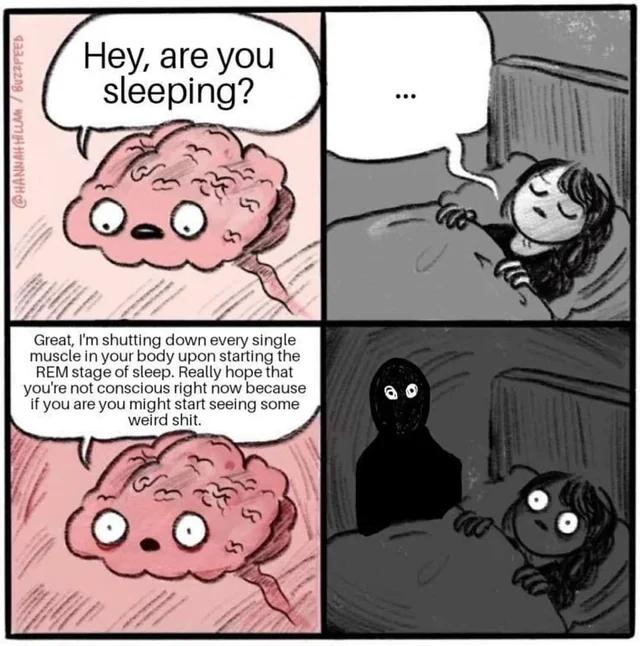"Being ridden by the witch" is the southern Americana folklore term for sleep paralysis. There are many more folk legends worldwide. In Fiji, it's kana tevoro, or being eaten by a demon. It's sometimes cultivated there with shouts of kania! kania! ("eat! eat!") from persons watching the victim in an effort to prolong the experience and enable communication with the dead. In Turkey, it's the djinn (another demon) strangling you in your sleep and is only remedied by reading passages from the Qur'an. In parts of China, it's a mouse stealing your breath. In Catalan folklore—of pooping Christmas log fame—it's a giant dog or cat that enters your room and sits on your chest while you sleep. (Catalan folklore is the best.) But, usually, it's some variation of witch or demon suffocating and otherwise torturing the victim.
There's even a Swedish horror movie about the phenomenon.
...
A ~~2012~~ 1999 study in the journal Consciousness and Cognition attempts to tie centuries of "remarkably consistent" folklore surrounding sleep paralysis folklore to sleep neurophysiology. That is, there's more to the connection than just sleep paralysis phenomenon causing enough terror to lead its victims to conjure the supernatural. The unique sensation of "being ridden by the witch" traces nicely enough to real-world brain stuff. For one, sleep paralysis induces a "hypervigilant" state in the brain. This is a fairly specific condition in which a person goes into an extreme alert mode where all of their senses become super-sensitive. The result is wildly exaggerated real-world stimuli. It's a diagnostic criterion for PTSD and, as the resulting anxiety ramps up, delusions and hallucinations set in. According to the paper, this is the witch, the other person with you in the room sucking the breath out of the victim's chest.
Actually, hypervigilance accounts for only the witch, not the breath-sucking. That sensation traces to a second factor. This factor is, in biospeak, due to hyperpolarization of motoneurons. In other words, it becomes more difficult to transmit a signal down a pathway of motor neurons (the ones that control muscle movement) because of an increase in the electrical potential between different neurons. It takes more spark to get the brain's message where it needs to go, like your diaphragm muscles.
This is what happens normally when you're in the REM (rapid eye movement) stage of sleep. After all, breathing is usually an unconscious reflex anyway; you don't need to fire messages from your conscious brain to your diaphragm to make respiration work. It just happens. Sensors around your heart detect changes in blood pH due to increase and decreases in carbon dioxide (see above), and fire messages to your brain's respiratory center in the Medulla oblongata, which fires the appropriate messages back down to your lungs. It's all pretty neat.
Anyhow, that's the unbearable crushing on your chest. Your body has naturally shut its motoneurons down because you're supposed to be asleep anyway and it doesn't want you acting out dreams. But in sleep paralysis it's only half-asleep, a collision of the REM sleep stages (body paralyzed, brain unconscious, dreams) and wakefulness, two stages bridged by NREM sleep (non-rapid eye movement, no dreams). NREM, partially characterized by the body not being paralyzed, itself has different stages, the first one of which involves the transition from waking thought to unconsciousness. In sleep paralysis, it's an overlap of these stages; the body is still paralyzed as in REM sleep but the brain is kicking out alpha waves, the signal that wakefulness has arrived. In consciousness, alpha waves are associated with resting or relaxing, while beta waves are associated with focus and, crucially, the body's stress responses. The first neurophysiological study of sleep paralysis, done by Takeuchi et al only 20 years ago, found that even beta waves were intruding into sleep. This isn't a thing that happens ever in normal sleep. Beta waves mean full-on awake.
